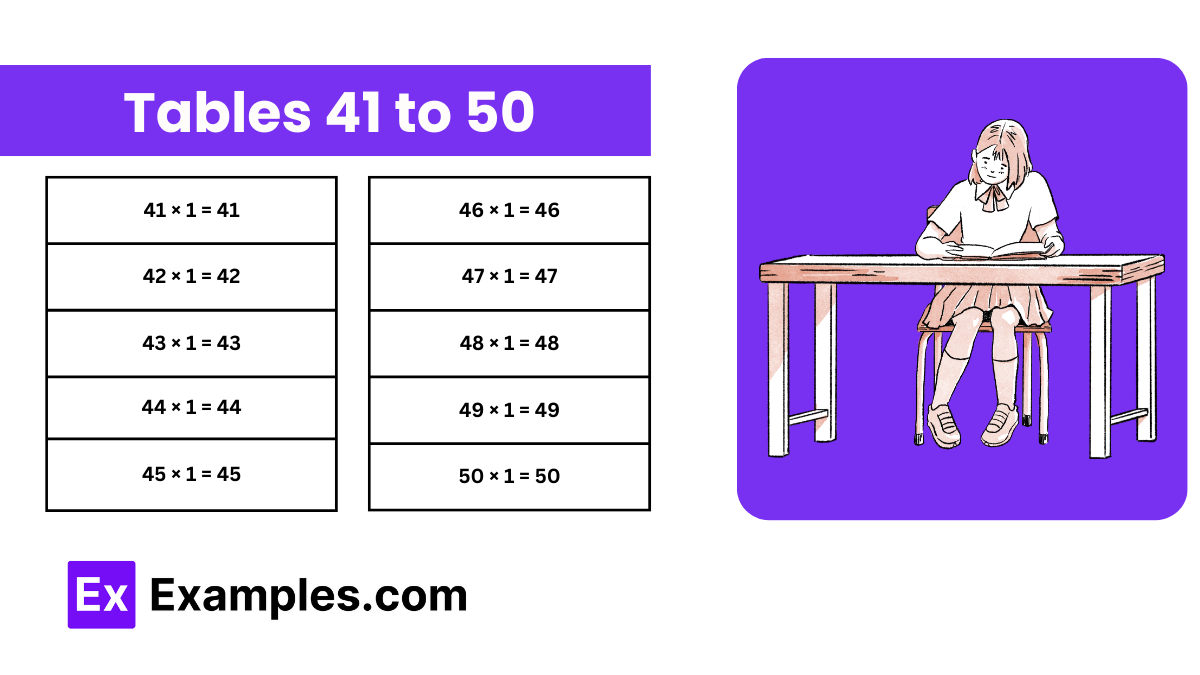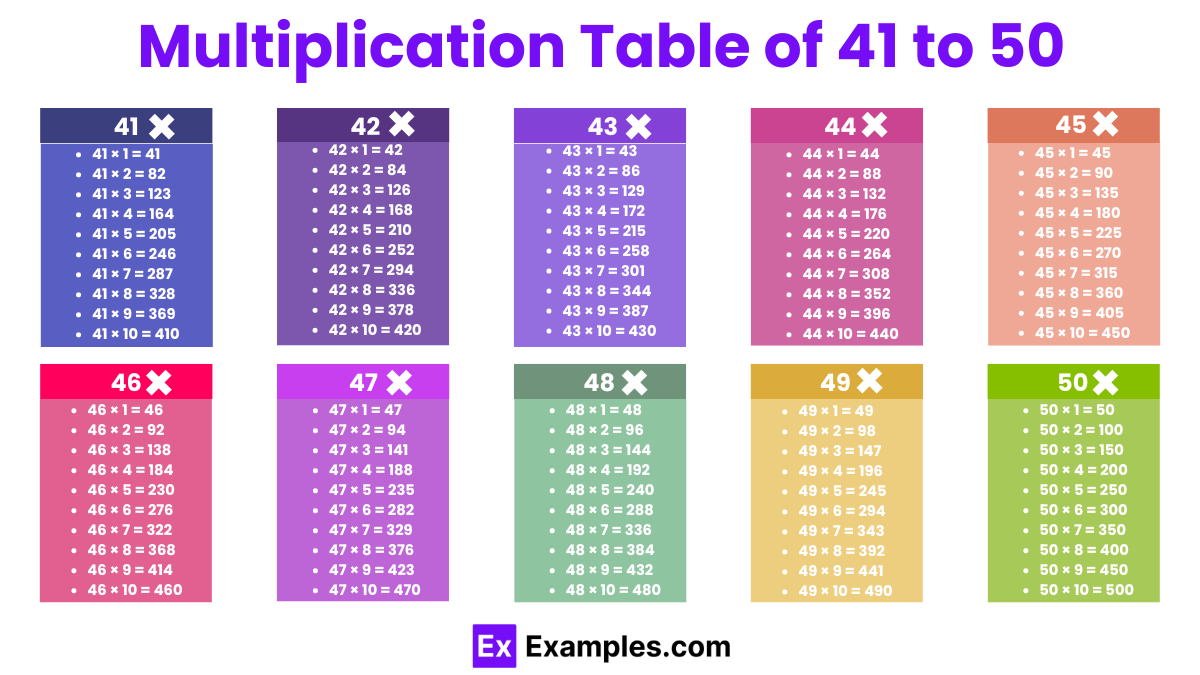What is 42 multiplied by 7?
288
294
300
306


Explore the multiplication tables from 41 to 50 to enhance your mathematical skills. These tables are crucial for advanced arithmetic, helping with quicker mental calculations and improving problem-solving abilities in both academic and real-world applications. Downloadable charts and strategic learning tricks can simplify the memorization process.

Download Tables of 41 to 50 Chart Pdf
The multiplication tables from 41 to 50 represent an essential resource for students tackling higher numerical ranges, critical for advanced mathematics. As learners progress through educational levels, the ability to quickly multiply larger numbers becomes increasingly important. A multiplication chart covering tables 41 to 50 simplifies this task, serving as a handy reference that enhances the calculation speed and accuracy required in subjects such as algebra, geometry, and calculus.
Download Tables From 41 to 50 Chart Pdf
| 41 Table | 42 Table | 43 Table | 44 Table | 45 Table |
|---|---|---|---|---|
| 41 × 1 = 41 | 42 × 1 = 42 | 43 × 1 = 43 | 44 × 1 = 44 | 45 × 1 = 45 |
| 41 × 2 = 82 | 42 × 2 = 84 | 43 × 2 = 86 | 44 × 2 = 88 | 45 × 2 = 90 |
| 41 × 3 = 123 | 42 × 3 = 126 | 43 × 3 = 129 | 44 × 3 = 132 | 45 × 3 = 135 |
| 41 × 4 = 164 | 42 × 4 = 168 | 43 × 4 = 172 | 44 × 4 = 176 | 45 × 4 = 180 |
| 41 × 5 = 205 | 42 × 5 = 210 | 43 × 5 = 215 | 44 × 5 = 220 | 45 × 5 = 225 |
| 41 × 6 = 246 | 42 × 6 = 252 | 43 × 6 = 258 | 44 × 6 = 264 | 45 × 6 = 270 |
| 41 × 7 = 287 | 42 × 7 = 294 | 43 × 7 = 301 | 44 × 7 = 308 | 45 × 7 = 315 |
| 41 × 8 = 328 | 42 × 8 = 336 | 43 × 8 = 344 | 44 × 8 = 352 | 45 × 8 = 360 |
| 41 × 9 = 369 | 42 × 9 = 378 | 43 × 9 = 387 | 44 × 9 = 396 | 45 × 9 = 405 |
| 41 × 10 = 410 | 42 × 10 = 420 | 43 × 10 = 430 | 44 × 10 = 440 | 45 × 10 = 450 |
| 46 Table | 47 Table | 48 Table | 49 Table | 50 Table |
|---|---|---|---|---|
| 46 × 1 = 46 | 47 × 1 = 47 | 48 × 1 = 48 | 49 × 1 = 49 | 50 × 1 = 50 |
| 46 × 2 = 92 | 47 × 2 = 94 | 48 × 2 = 96 | 49 × 2 = 98 | 50 × 2 = 100 |
| 46 × 3 = 138 | 47 × 3 = 141 | 48 × 3 = 144 | 49 × 3 = 147 | 50 × 3 = 150 |
| 46 × 4 = 184 | 47 × 4 = 188 | 48 × 4 = 192 | 49 × 4 = 196 | 50 × 4 = 200 |
| 46 × 5 = 230 | 47 × 5 = 235 | 48 × 5 = 240 | 49 × 5 = 245 | 50 × 5 = 250 |
| 46 × 6 = 276 | 47 × 6 = 282 | 48 × 6 = 288 | 49 × 6 = 294 | 50 × 6 = 300 |
| 46 × 7 = 322 | 47 × 7 = 329 | 48 × 7 = 336 | 49 × 7 = 343 | 50 × 7 = 350 |
| 46 × 8 = 368 | 47 × 8 = 376 | 48 × 8 = 384 | 49 × 8 = 392 | 50 × 8 = 400 |
| 46 × 9 = 414 | 47 × 9 = 423 | 48 × 9 = 432 | 49 × 9 = 441 | 50 × 9 = 450 |
| 46 × 10 = 460 | 47 × 10 = 470 | 48 × 10 = 480 | 49 × 10 = 490 | 50 × 10 = 500 |
Example 1: Table of 41
Problem: 41 x 9 = ?
Solution: 41 x 9 = 369 (Forty-one times nine equals three hundred sixty-nine.)
Example 2: Table of 42
Problem: 42 x 5 = ?
Solution: 42 x 5 = 210 (Forty-two multiplied by five results in two hundred ten.)
Example 3: Table of 43
Problem: 43 x 7 = ?
Solution: 43 x 7 = 301 (Forty-three times seven yields three hundred one.)
Example 4: Table of 44
Problem: 44 x 8 = ?
Solution: 44 x 8 = 352 (Forty-four times eight equals three hundred fifty-two.)
Example 5: Table of 45
Problem: 45 x 10 = ?
Solution: 45 x 10 = 450 (Forty-five multiplied by ten results in four hundred fifty.)
Example 6: Table of 46
Problem: 46 x 6 = ?
Solution: 46 x 6 = 276 (Forty-six times six equals two hundred seventy-six.)
Example 7: Table of 47
Problem: 47 x 4 = ?
Solution: 47 x 4 = 188 (Forty-seven times four yields one hundred eighty-eight.)
Example 8: Table of 48
Problem: 48 x 9 = ?
Solution: 48 x 9 = 432 (Forty-eight multiplied by nine results in four hundred thirty-two.)
Example 9: Table of 49
Problem: 49 x 3 = ?
Solution: 49 x 3 = 147 (Forty-nine times three equals one hundred forty-seven.)
Example 10: Table of 50
Problem: 50 x 7 = ?
Solution: 50 x 7 = 350 (Fifty times seven results in three hundred fifty.)
Effective strategies include incorporating hands-on activities, using manipulatives, playing multiplication games, providing individualized instruction, giving positive reinforcement, and encouraging students to explain their thinking processes. Additionally, integrating the tables into other subjects or daily routines can reinforce learning.
You can help your child by making learning fun through games, providing visual aids, encouraging regular practice, using real-life examples, offering rewards for progress, and being patient and supportive throughout the learning process.
Resources for learning these tables include multiplication worksheets, online games and apps, educational websites, flashcards, books, and educational videos. You can also create your own materials tailored to your learning style and preferences.
The time it takes to learn these tables varies depending on individual learning styles, prior knowledge, and practice habits. With consistent practice and dedication, most individuals can master these tables within a few weeks to a few months.
You can practice by using flashcards, doing mental math exercises, participating in multiplication games, incorporating the tables into daily activities, and regularly reviewing the tables to reinforce memory.
Text prompt
Add Tone
10 Examples of Public speaking
20 Examples of Gas lighting
What is 42 multiplied by 7?
288
294
300
306
Calculate 49 × 6 using the distributive property.
288
294
300
306
What is the product of 43 and 5?
210
215
220
225
What is 45 times 11 using repeated addition?
490
495
500
505
Find the result of 44 × 8 using the distributive property.
342
352
362
372
What is the result of 46 × 6 using breaking it down?
264
276
278
282
Calculate 47 × 12.
564
576
586
594
What is 48 times 4 using repeated addition?
182
184
186
192
Find 50 × 15 using the distributive property.
730
740
750
760
What is 50 times 18 using the distributive property?
870
880
890
900
Before you leave, take our quick quiz to enhance your learning!

